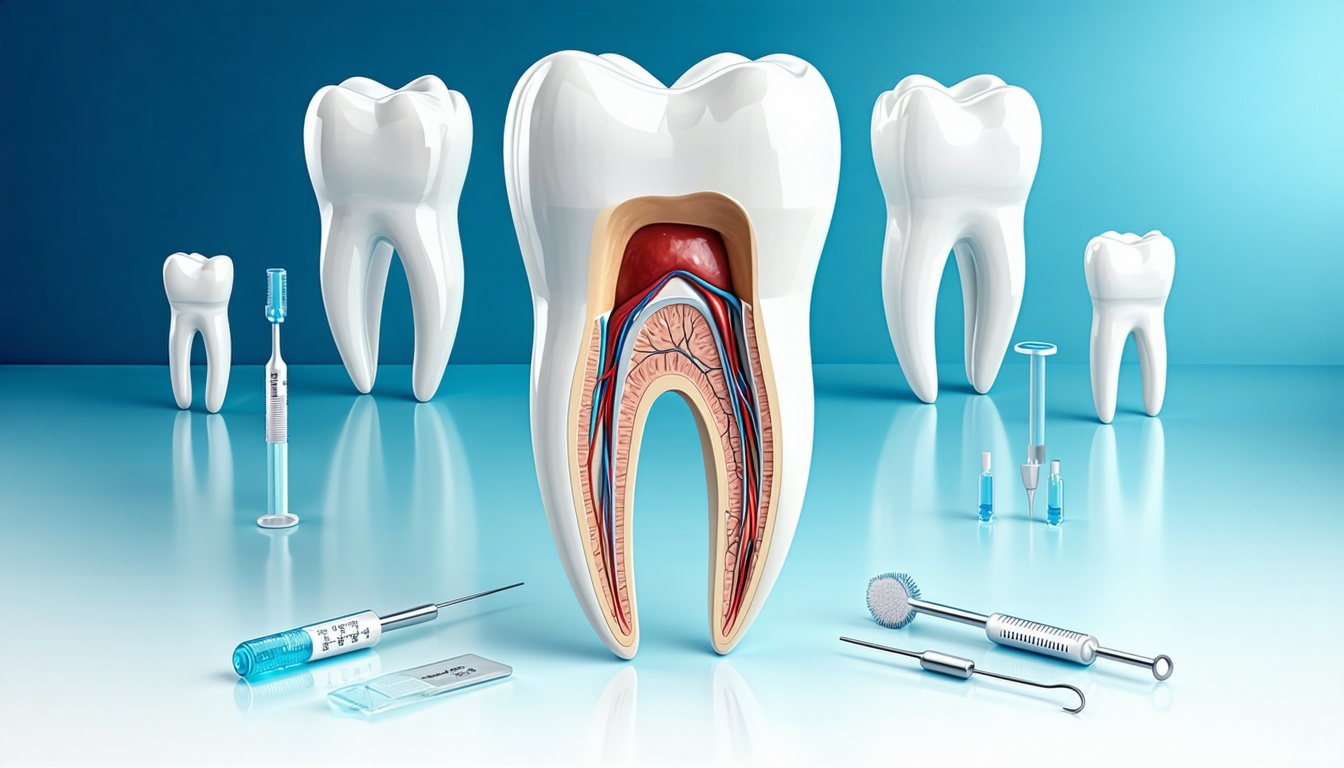Understanding Root Canal Treatment
What is a Root Canal?
A root canal is a dental procedure that involves removing damaged or infected pulp from within a tooth. When the pulp becomes inflamed or infected due to deep decay, repeated dental procedures, or cracks in the tooth, a root canal is necessary to alleviate pain and prevent the infection from spreading to other teeth. During the treatment, your dentist will clean the inside of the tooth, remove the damaged pulp, and seal off the space to protect it from future infection (American Association of Endodontists). This method is often the preferred approach, allowing you to save your natural tooth instead of undergoing extraction.
| Root Canal Key Points | Description |
|---|---|
| Procedure Purpose | Remove infected pulp to relieve pain and prevent infection |
| Steps Involved | Cleaning, sealing, and protecting the tooth |
| Alternatives | Tooth extraction is a common alternative |
For more details, refer to our article on what is root canal treatment.
Importance of Root Canal Therapy
Root canal therapy is essential for preserving your natural teeth. The procedure not only alleviates discomfort caused by tooth decay or infection, but it also prevents the spread of infection to surrounding teeth (Cleveland Clinic). Most root canals are successful and can provide relief for many years, even lasting a lifetime if properly cared for.
This treatment is considered a common and predictable solution when performed by experienced dental professionals. Many patients report satisfaction with their results after experiencing minimal recovery discomfort (Dental Perfections). It’s a treatment that helps maintain the tooth’s functionality long-term, ensuring you can continue to enjoy your natural smile. Understanding the significance of root canal therapy can help you make informed decisions about your dental health and pain management options, without resorting to more drastic measures like extraction.
For a clearer understanding of this process, visit our section on the root canal procedure steps and learn more about how long the procedure typically takes with our article on how long does a root canal take.
Need for Root Canal Treatment
Signs You Need a Root Canal
Recognizing the signs that you might need a root canal is crucial for preserving your natural teeth and alleviating discomfort. Common indicators include:
| Symptom | Description |
|---|---|
| Persistent Tooth Pain | Ongoing pain that may worsen when biting or chewing. |
| Sensitivity | Increased sensitivity to hot or cold, even after the source has been removed. |
| Swelling | Swelling and tenderness in surrounding gums. |
| Gum Boil | A pimple-like bump on the gums that may drain pus, indicating infection. |
| Darkening of the Tooth | Discoloration of the tooth may occur as the pulp becomes necrotic. |
If you experience any of these symptoms, it’s best to consult with your dentist. Often, these signs point to pulp infection—an issue that needs prompt attention to avoid complications. Learn more about these indicators in our article on signs you need a root canal.
Causes of Pulp Infection
The pulp of your tooth contains nerves and blood vessels. When it becomes inflamed or infected, a root canal is often necessary. Here are some common causes of pulp infection:
| Cause | Explanation |
|---|---|
| Deep Decay | Cavities that penetrate through the enamel and dentin into the pulp can cause infection. |
| Repetitive Dental Procedures | Multiple procedures on the same tooth can increase the risk of pulp inflammation. |
| Cracked or Chipped Tooth | Damage to the tooth from trauma can allow bacteria to enter and infect the pulp. |
| Gum Disease | Advanced gum disease can lead to pulp infection due to infection spreading from the gums. |
Understanding these potential causes can help you maintain better dental health and possibly avoid the need for a root canal. If you have questions about how to prevent pulp infection, check out our resources on root canal vs tooth extraction and discover how root canal treatment works with our article on what is root canal treatment.
Process of Root Canal Treatment
Understanding the process of root canal treatment can help alleviate concerns about the procedure. You may be wondering what to expect during the treatment and how long it will take.
Step-by-Step Procedure
The root canal procedure typically follows a systematic approach designed to effectively remove infected tissue and preserve your tooth. Here are the general steps involved:
- Anesthesia Administration: Your dentist will first administer a local anesthetic to numb the affected tooth and surrounding area.
- Access Opening: A small opening is made in the crown of the tooth to access the pulp chamber and root canals.
- Pulp Removal: The infected or damaged pulp is gently removed using specialized instruments.
- Cleaning and Shaping: The empty canals are cleaned and shaped to prepare for filling. This step ensures the removal of any residual bacteria.
- Filling the Canals: After cleaning, the canals are filled with a biocompatible material called gutta-percha to seal them.
- Temporary Filling: A temporary filling is applied to close the access opening until the tooth is ready for a permanent restoration.
- Follow-Up Appointments: Typically, you will schedule additional appointments to place a crown or other permanent restoration on your tooth.
For a detailed insight, check our article on root canal procedure steps.
Duration and Number of Appointments
Most root canal procedures can be completed in one to two appointments. Each appointment typically lasts around 60 to 90 minutes, allowing for efficient treatment (American Association of Endodontists). In some cases, additional visits may be necessary for placing a permanent restoration, such as a crown. Here is a summary of the appointment structure:
| Appointment Type | Duration (minutes) | Notes |
|---|---|---|
| Initial Root Canal | 60 – 90 | First stage of treatment |
| Crown Preparation | 30 – 60 | After initial treatment |
| Crown Placement | 30 – 60 | Final visit for restoration |
For further details on potential duration, refer to our article on how long does a root canal take.
The aftercare post-treatment is important. After your root canal, you may want to explore root canal pain relief tips or learn more about root canal recovery time. Understanding the steps and time involved can ease any concerns about having a root canal, guiding you toward preserving your natural teeth effectively.
Recovery After Root Canal
Recovering from a root canal is an important phase in ensuring the success of your treatment. Understanding the signs of post-treatment sensitivity and knowing how to care for your teeth during this time can greatly enhance your healing experience.
Post-Treatment Sensitivity
After undergoing a root canal procedure, you may experience sensitivity and discomfort around the treated area. Most patients feel slightly sore on the day of the procedure and for the next 24 hours due to irritation from vibrations and pressure during treatment (Palisades Endodontics). It’s common to manage this discomfort with over-the-counter pain medications.
| Time Frame | Description |
|---|---|
| Day of treatment | Numbness from anesthesia (2-4 hours) |
| 1-2 days post-treatment | Mild soreness, manageable with medications |
| 1 week | Sensitivity may still be present but is generally mild |
As you continue to heal, the sensitivity should gradually diminish within a week. If you experience lingering pain beyond one week, it’s advisable to contact your healthcare provider for further evaluation. For tips on managing discomfort during recovery, visit our page on root canal pain relief tips.
Follow-Up Care and Appointments
After your root canal treatment, follow-up care is vital for ensuring proper healing and maintaining the integrity of your tooth. Most root canals can be completed within one to two appointments, with each visit lasting approximately 90 minutes (American Association of Endodontists).
It is important to schedule any necessary follow-up appointments to monitor your recovery and check if you need a crown or further restorative work. Practicing good oral hygiene during your recovery will support healing and help prevent complications.
If you have questions or concerns during your recovery, don’t hesitate to refer to the root canal FAQ or your dentist for guidance. Taking the right steps post-treatment can make a significant difference in the outcome of your root canal therapy. For information on what indicates you may need a root canal, check our article on signs you need a root canal.
Risks and Complications
Understanding the potential risks and complications associated with root canal therapy can help you make informed decisions about your dental health. While the procedure is designed to alleviate pain and save your tooth, it is essential to be aware of possible issues that may arise.
Common Risks Associated
Root canal treatment, like any medical procedure, carries certain risks. Here are some common complications you may encounter:
| Risk | Description |
|---|---|
| Infection | In rare cases, new infections can occur after treatment due to incomplete sealing of the root canals or new issues developing. |
| Reinfection | The risk of reinfection is a significant concern for patients, often resulting from seal failure that allows bacteria to re-enter the tooth. (Dental Perfections) |
| Instrument Breakage | Though rare, tools used during the procedure may break and require further intervention. |
| Cracked Tooth | Some patients may experience cracking due to the amount of tooth structure removed during the treatment. |
| Sinus Congestion | There is a possibility of liquid leaking from the jaw into the nasal membranes, causing headaches and congestion. This is generally mild and resolves within a few weeks. (Dental Perfections) |
| Allergic Reactions | Allergic reactions to materials used in the procedure, like rubber dams or irrigation solutions, may occur but are rare. (Ironwood Dental Care) |
| Brittle Teeth | Post-treatment, teeth may become brittle due to the removal of living tissue, necessitating crowns for added strength. |
| Nerve Disruption | In an extremely small percentage of cases, disruption to surrounding nerves can lead to temporary numbness. (Dental Perfections) |
Managing Potential Complications
To mitigate risks and manage potential complications effectively, consider the following steps:
-
Choose an Experienced Dentist: Selecting a qualified and experienced dental professional can significantly reduce the risk of complications. Make sure to ask about their training in root canal therapy.
-
Follow Pre-Treatment Guidance: Adhere to any pre-treatment instructions provided by your dentist. This may include avoiding certain medications or discussing health conditions that could affect the procedure.
-
Post-Treatment Care: After your root canal, diligently follow your dentist’s post-treatment care instructions to ensure proper healing. This includes taking prescribed medications, which may help manage pain and prevent infection.
-
Monitor for Symptoms: Be vigilant about monitoring any unusual symptoms post-treatment, such as increased pain or swelling. If you experience these, contact your dentist immediately.
-
Regular Check-Ups: Schedule follow-up appointments to ensure that your tooth is healing properly and there are no signs of reinfection or complications.
-
Consider Treatment Alternatives: In some cases, discussing the option of root canal vs tooth extraction with your dentist may provide clarity on the best course of action for your situation.
Being informed about the risks and how to manage them empowers you to take proactive steps for maintaining your dental health. If you have any further questions, consult with your dentist or refer to our root canal FAQ for more insights.
Long-Term Benefits
Success Rates of Root Canal Treatment
Understanding the advantages of root canal treatment can help alleviate concerns you may have about undergoing this procedure. According to the Cleveland Clinic, most root canals are extremely successful, boasting high success rates.
| Success Rate | Duration |
|---|---|
| 85% – 97% | Lasts for many years, often a lifetime |
The procedure effectively eliminates pain and infection, making it a preferred option for managing dental issues associated with pulp damage. The relief from pain and the prevention of further infection contributes not only to your dental health but also to your overall well-being.
Preservation of Natural Teeth
One of the primary benefits of root canal treatment is the preservation of your natural teeth. When you opt for a root canal instead of extraction, you are taking a vital step towards maintaining your original dental structure. Root canals clean and seal the canals to prevent bacteria from reaching the pulp, which can cause significant damage or pain (Cleveland Clinic).
The advantages of keeping your natural tooth include:
- Better Functionality: Preserved teeth contribute to proper chewing and biting.
- Aesthetics: Natural teeth can enhance your smile without the need for artificial replacements.
- Bone Health: Retaining your natural teeth can support jawbone health, as missing teeth can lead to bone loss over time.
Choosing root canal treatment over extraction offers you the chance to maintain your dental health effectively. You can explore more about the differences between these two options by checking our article on root canal vs tooth extraction. Ultimately, understanding the long-term benefits of root canal therapy can empower you to make informed decisions regarding your dental care.










